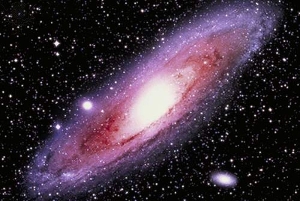Research project
A new window on the Universe
The formation and evolution of clusters and proto-clusters
- Contact
- Huub Rottgering
- Funding
-
 ERC Advanded Grant
ERC Advanded Grant

The formation and evolution of clusters and proto-clusters of galaxies will be studied using unique diagnostic tools provided by the new pan-European radio telescope LOFAR and the APERTIF phased arrays on the WSRT radio telescope. These new facilities will for the first time enable sensitive observations from the lowest possible frequencies accessible from the ground (~10 MHz) up to 1400 MHz. The guaranteed time projects (PI HR) to carry out ultra deep pointed observations and to survey the entire northern sky will be unique in terms of angular resolution, depth, and extremely large frequency range. This will enable me to carry out a coherent study of clusters of galaxies over the entire history of the universe up to the formation of the first proto-clusters.
Our recent work established that diffuse cluster radio sources trace giant shock waves generated when two sub-clusters merge to form a larger one. LOFAR’s unprecedented sensitivity at ultra-low frequencies and large observing bandwidth are ideally suited to observe such radio sources in nearby clusters. This will constrain (i) the geometry of merger events, (ii) the physics of cluster wide shocks and particle acceleration, (iii) the origin of cosmic magnetic fields, and (iv) the energy content of the thermal and non-thermal cluster gas.
Currently, diffuse radio synchrotron sources have been detected in about 50 nearby massive galaxy clusters. With its huge sensitivity and large field of view, LOFAR has the potential to detect thousands of these systems, up to redshifts z=1-2, when the first bound clusters appeared. Studies of the associated shock waves produced by cluster mergers and the magnetic field properties of the cluster gas will constrain models of the formation of galaxy clusters.
The large fields of view of both LOFAR and APERTIF will enable the detection of radio emission from millions of star-forming galaxies up to z=2-3, at the epoch at which the bulk of galaxy formation is believed to have occurred. In combination with infrared surveys, the first significant sample of the ancestors of massive clusters of galaxies, proto-clusters, will be obtained. This will enable the first complete study of the overall properties of proto-clusters and their galaxy contents.
With LOFAR’s ability to pinpoint radio sources with extremely steep radio spectra, we will detect radio galaxies at unprecedented distances. As my previous radio and optical investigations have established that distant radio galaxies are often located in proto-clusters, the most distant LOFAR radio galaxies will be excellent targets to locate and study the first proto-clusters close to or even at the epoch of reionisation. LOFAR radio spectroscopy targeting neutral hydrogen 21 cm absorption would, for the first time, determine physical characteristics of neutral gas in such objects. Subsequent observations with large optical and IR telescopes will constrain models of how massive galaxies and associated massive black holes form within the first collapsing over-densities in the early Universe.
